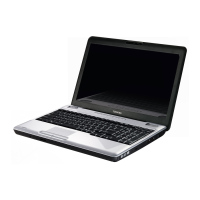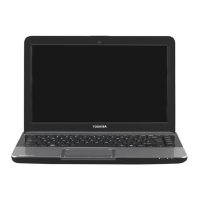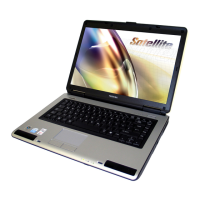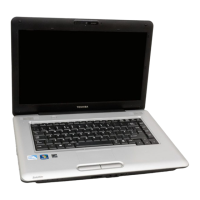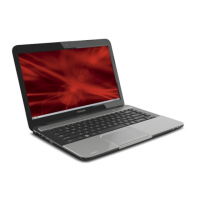
Do you have a question about the Toshiba L10 Series and is the answer not in the manual?
| Memory | Up to 2GB DDR SDRAM |
|---|---|
| Display | 15.0" XGA TFT (1024 x 768) |
| Hard Drive | 40GB |
| Optical Drive | DVD-ROM |
| Operating System | Windows XP Home Edition |
| Wireless | 802.11b/g |
| Ports | 3 x USB 2.0, VGA, Headphone, Microphone |
| CPU | Intel Celeron M |
| Graphics | Integrated Intel Graphics Media Accelerator (GMA) |
Provides information regarding the accuracy and limitations of the manual content.
General warning about laser product usage and safety.
Information on preventing stress injuries from keyboard use.
Precautions regarding the computer and AC adaptor becoming hot.
Advice on avoiding damage from pressure or impact.
Overview of the manual's structure: chapters, appendixes, glossary, and index.
Explains formats used for descriptions, identification, and highlighting.
Defines abbreviations used in the manual.
Explanation of icons used to identify parts and provide information.
Details on how keyboard keys are represented in the text.
Instructions on using key combinations for operations.
Explanation of how screen elements are presented.
Identifies different message types used for important information.
Lists items to check after unpacking the computer.
Lists essential hardware components included with the computer.
Details preinstalled software and documentation.
Highlights the computer's advanced features and benefits.
Describes the computer's hard disk and optical media drives.
Information on the LCD panel and graphics controller.
Details about the computer's keyboard layout and keys.
Information on the built-in TouchPad.
Describes external monitor, USB, and multimedia ports.
Details about the PC Card slot.
Explains sound system, video-out, and audio/video control buttons.
Information on built-in modem, LAN, and Wireless LAN features.
Highlights unique and advanced computer features.
Describes preinstalled utilities and how to start them.
Details available optional devices to enhance computer capabilities.
Identifies components on the front of the computer when the display is closed.
Identifies ports and vents on the left side of the computer.
Identifies drives and indicators on the right side of the computer.
Identifies ports on the back panel of the computer.
Shows the underside of the computer and its components.
Identifies components on the front when the display is open.
Explains the function of system and keyboard status indicators.
Details the optional external USB floppy disk drive.
Describes installed optical media drives and region codes.
Information on DVD disc types and formats supported.
Details the AC adaptor's function and specifications.
Guidance on establishing a comfortable and safe work environment.
Step-by-step instructions for installing the computer's battery pack.
Instructions for connecting the AC adaptor for power and charging.
Guidance on opening and adjusting the computer's display panel.
Procedure for powering on the computer for the first time.
Instructions for the initial setup of the Windows XP operating system.
Describes modes for shutting down the computer: Shut Down, Hibernation, Standby.
Explains how Hibernation Mode saves memory to the hard disk.
Details on using Standby Mode for work interruption.
Provides methods for resetting the computer system.
Guides on restoring the operating system and preinstalled software.
Instructions on how to use the computer's TouchPad for navigation.
Details on connecting and using the external USB floppy disk drive.
Information on using the computer's optical media drives.
Step-by-step guide for loading discs into the optical drive.
Instructions on how to remove discs from the optical drive.
Explains the function of the audio/video control buttons.
Precautions for writing CDs with the DVD-ROM/CD-RW drive.
Precautions for writing CDs/DVDs with the DVD Super Multi drive.
Information and limitations for the RecordNow! software.
Tips for protecting data on CD/DVDs and floppy disks.
Details on audio controls including volume and microphone levels.
Instructions on connecting and disconnecting the internal modem.
Guide to selecting the correct modem region for telecommunication regulations.
Information on Wireless LAN features, security, and communication switch.
Details on built-in Ethernet LAN support and cable types.
Instructions for safely cleaning the computer's exterior and vents.
Precautions to take when moving or transporting the computer.
Explanation of the basic keys for typing letters, numbers, and symbols.
Describes the function keys and their usage with the Fn key.
Details on keyboard shortcuts for enabling/disabling features.
Instructions for adjusting the display brightness using Fn keys.
Information on enabling/disabling the TouchPad function.
Explains the special function keys for Windows.
Guide to using the numeric keypad overlay feature.
Details how AC adaptor connection and battery status affect power.
Information on the computer's main battery pack and its care.
Explains the RTC battery's function and replacement.
Safety precautions and guidelines for battery pack usage.
Instructions and procedures for charging the computer's battery.
Tips and procedures to maximize the battery pack's operational life.
Steps for removing and installing a new battery pack.
Describes the computer's power-up modes: Boot, Hibernation, and Standby.
Details on PC cards and memory expansion options.
Information on optional additional battery packs and AC adaptors.
Describes optional peripheral devices like floppy drives and monitors.
Information on additional optional devices like security locks.
Details on the computer's PC Card expansion slot.
Instructions for installing and removing memory modules.
Information on purchasing and using additional battery packs.
Details on connecting the external USB floppy disk drive.
Guide for connecting an external monitor to the computer.
Instructions for connecting the computer to a television set.
How to attach a security lock to prevent unauthorized removal.
Guidelines for effectively resolving computer problems.
Basic troubleshooting steps for common issues.
Questions to help identify the cause of system malfunctions.
Checklists for problems related to hardware and system components.
Troubleshooting steps for keyboard-related issues.
Troubleshooting steps for LCD panel display problems.
Troubleshooting steps for hard disk drive issues.
Troubleshooting for the DVD-ROM and CD-R/RW drive.
Troubleshooting steps for the DVD Super Multi drive.
Troubleshooting steps for the floppy disk drive.
Troubleshooting steps for PC Card errors.
Troubleshooting steps for the computer's pointing device.
Troubleshooting steps for issues with a USB mouse.
Troubleshooting steps for USB device connectivity problems.
Troubleshooting steps for memory expansion issues.
Troubleshooting steps for sound system problems.
Troubleshooting steps for external monitor issues.
Troubleshooting steps for modem communication problems.
Troubleshooting steps for LAN access issues.
Troubleshooting steps for wireless LAN access problems.
Troubleshooting steps for printer connectivity and errors.
Information on obtaining technical assistance from TOSHIBA.
Details the computer's physical dimensions, weight, and size.
Specifies operating and non-operating environmental conditions.
Lists the AC adaptor and computer power specifications.
Provides specifications for the computer's built-in modem.
Explains the display controller's function and capabilities.
Details the computer's supported video modes and their parameters.
Guide for configuring display settings and multi-monitor setups.
Lists the technical specifications for the Wireless LAN card.
Specifies the form factor of the Wireless LAN card.
Details compatibility standards for Wireless LAN.
Specifies the supported network operating system.
Lists data rates and protocols for Wireless LAN.
Describes radio characteristics of Wireless LAN cards.
Details supported frequency bands and channels for Wireless LAN.
Specifies requirements for AC power cords and connectors.
Lists certification agencies for AC power cords in various regions.
Details European certification agencies for AC power cords.
Shows plug shapes and certifications for USA and Canada.
Shows plug shapes and certifications for the United Kingdom.
Shows plug shapes and certifications for Australia.
Provides steps to take and information needed if the computer is stolen.
Details on how to register a stolen computer online or on paper.
Section to fill in owner's contact information for theft registration.
A list of abbreviations used throughout the manual.




